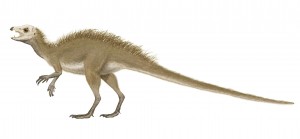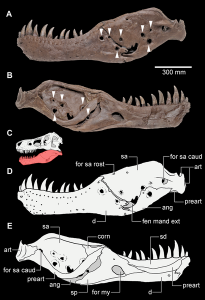Guest Post
For the Dinosaur connoisseur and collector, you will find what you have been looking for at Dinosaur Model Toys.com. The creator of all the works featured on this site is not only a gifted sculptor, but actually works with dinosaur fossils as a paleontological reconstruction artist, fossil preparator, and field technician at the Natural History Museum of Los Angeles. His artwork is based on the latest scientific research, real fossil material, and years of hands on experience. This is why the work featured is regarded as some of the most scientifically accurate available to the public.
The new Dinosaur Galleries at the Natural History Museum of Los Angeles will feature many of the artist’s creations. Most notable is the baby Tyrannosaurus rex estimated to have been two years old when it died, for which nearly ninety percent of the skeleton will be recreated for this mount. This sculpted reconstruction will be featured with two real T-rex specimens, one a six-year old, and the other the sub adult specimen named “Thomas” which Doyle Trankina helped collect, and prepare. Thomas is estimated to be about seventy percent complete, making it one of the top five most complete in the world. Our initial offering will be a series of cast resin models and limited edition bronze sculptures with both a highly detailed exterior view, and a rendition of the internal skeletal anatomy of an adolescent T-rex similar to the Thomas find.
As part of the Dinosaur Institute at the Natural History Museum of Los Angeles Doyle Trankina has attended several field excavations in Montana, Utah, and the Mojave. While in the field Doyle prospected, and assisted in the collection of several specimens, most notably Thomas the sub adult Tyrannosaurus rex that will be gracing the museum’s new Dinosaur Gallery in 2011. Through his experiences with the museum with his private obsession with prehistoric life and the natural world, Doyle has produced several sculptures and illustrations for exhibition and publication. Doyle has an extensive list of sculptures to produce over the next two years. His work will require lots of observational study from the museum’s collection, and extensive extrapolation based on the latest research, and modern analogues like birds, and crocodiles.
After completing the preparation of Thomas, Doyle embarked on a half skeletal, half flesh reconstruction of an adolescent Tyrannosaurus rex at 1;24th scale. The detail and fidelity to the skeleton was accomplished by long study of the anatomy from several existing mounts, scientific publications, and photographs from the some of the best Tyrannosaurus specimens. The teeth were surfaced to provide the accurate thickness and semblance to where the tinny serrations would have lined the many teeth. Because the position of the serrations actually change on the teeth as they move back towards the throat, the ridge implies the appropriate location of the serrations. The scales were carved individually so that the skin wraps around the form in a realistic, and accurate way.
Doyle is currently working on a skeletal reconstruction of a baby Tyrannosaurus rex which will be mounted in the new Dinosaur Galleries with Thomas and an intermediate specimen as an illustration of age progression. The actual specimen is only known from a skull fragment from the snout of what is believed to be from a two-year-old Tyrannosaurus rex. There are no post cranial remains, and there are only a handful of examples that are believed to be that of baby dinosaurs. This project has just begun, and with Dr. Chiappe Doyle will be making history in presenting the worlds only mounted baby Tyrannosaurus rex specimen.
Fall of 2009 marked one of the biggest Paleontology news splashes, featuring N. America’s smallest dinosaur, Fruitadens haagarorum. Nearly 150 million year old, the tiny Fruitadens would have shared its life with such titanic beasts as Brachiosaursus, and Allosaurus in the late Jurassic. It is thought that the animal might have weighed as little as two pounds and measured only 28 inches in length. Fruitadens was discovered in Colorado in the late 1970s in a geological formation known as the Morrison, more specifically in an area called Fruita, for which the specimen was named after.

Artist reconstruction of the dinosaur Fruitadens
The strange dentition of this animal implies that Fruitadens might have been omnivorous, eating plants and at least insects if not small vertebrates. Doyle has produced the first and most accurate illustrated and sculpted reconstructions of this animal. Fruitadens belongs to a family of early dinosaurs called heterodontosaurids, which share many interesting features, one of which are the teeth. Fruitadens like other heterodontisaurids have varied dentition, and in the front of the mouth sits a canine like tooth on the lower jaw. His work was featured on every major news source in the world, and five of the sculpted Fruitadens will be featured in the new galleries in 2011. In his studio, Doyle is currently working on a scale Fruitadens, which will be approximately 30cm long . This will be the only scaled sculpture of the animal, and the first and only for sale. The full scale version is not for sale and can only be seen at the Museum.
Doyle is also concurrently working on Mamenchisaurus, a long neck dinosaur and part of the branch of Sauriscian (lizard hipped dinosaurs) known as Sauropods. As the prospects of obtaining a casting of the Chinese mamenchisaur skull proved too difficult, Doyle was charged with the task of reconstructing the skull from two dimensional reference and other dinosaurs like Camarasaurus for comparison, and to gain familiarirty with Sauropod skull anatomy. The rare skull was found in China and researchers provided a paper with a detailed description and several scientific illustrations. Sauropod skulls are rare because they are so frail in construction, have several small bones that usually disarticulated some time after the animal dies, and are not commonly preserved in fossilization, or are so disarticulated and in such small pieces that they are nearly impossible to find.
Doyle Trankina is a sculptor, illustrator and fossil preparator at the Los Angeles Museum of Natural History. For unique scientifically authenticated Dinosaur Art, Dinosaur Models and Dinosaur Resin Model Kits, visit his online store Dinosaur Model Toys.Com.
Many other interesting dinosaur facts can be found here at Boneblogger.

